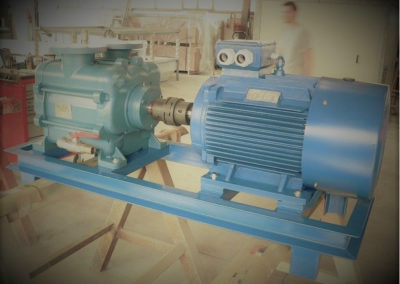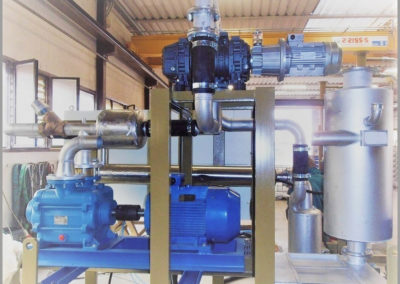TYPES OF VACUUM GENERATION SYSTEMS
-
Liquid ring vacuum pump
In the first years of vacuum drying (until 1980) the size of the plants was extremely small, usually 1 to 2 tables, 5 mt x 2.5 mt. These vacuum dryers used a simple liquid ring vacuum pump whose capacity (400-800 Mt³ / h) was more than enough. The limit of these pumps, however, was the achievable vacuum value, which could not be better thab 35 mBar. Under these conditions, the leather cannot be dried at less than 55 ° – 60 ° C. Even today, the most effective liquid ring vacuum pumps fail to overcome this limit.
-
Liquid ring vacuum pump: oil VS water
This kind of pump relies on an impeller and a liquid ring that rotates on a single axis to generate vacuum. This liquid can be water or oil. The oil supply entails considerable operating costs and constant maintenance. In fact, oil needs an exchanger for its cooling and constant monitoring of any leakage or contamination due to suction water. Water is certainly cheaper, and today it is the most widely used method, with less environmental impact and easy disposal. It can also use the existing evaporative tower technology for its cooling.
-
The turbo system
In the 1990s a new technology was applied to vacuum drying. To overcome the limit of the liquid ring pump, it was made to work with a compressor (blower), bringing the vacuum to values never seen before: 15-20 mBar. Thus it has been possible to dry the leathers at 45 ° – 50 ° C, coining the expression “low temperature vacuum”. In addition, increasing the flow to 1800 Mt³ / h, the size of the vacuum dryers reached an average of 4-5 floors 7 mt x 3 mt.
-
The dry pump
Over the past 10 years, many companies have been trying to develop a new vacuum generation technology by developing dry pumps. A dry vacuum generation system is usually made up of a number of screw pumps that cannot come into contact with liquids. The capacity of these vacuum pumps grows up to about 2500 Mt³/h.
-
Dry pump issues:
Maintenance experience has highlighted some drawbacks in dry pump technology. Although their capacity is considerably higher than the previous vacuum systems, dry pumps are subject to sudden and unexpected blockages and breaks.
Vacuum pumps are always reached by the evaporation from the leather. This moisture is rich in extremely aggressive chemicals used in the tanning process. The deposition of these residues, along with metal corrosion, ends up by locking the internal gears to the pump. In the liquid ring pump, the gears are cleaned and protected by the liquid itself, which prevents deposits and corrosion. In the dry pump these screed layers accumulate unpredictably, creating a risk of sudden machine lock. Replacing a dry pump has very high costs and usually longer times than any other vacuum system.
Dry pumps also need to be heated before work, and cooled at the end of the shift. These waiting times are not present when using a liquid ring pump. -
Double Turbo Liquid Ring (ICE VACUUM)
To achieve a vacuum system that combines the high power of the dry pump with the reliability of the water ring pump, Mec Man developed a dual turbo vacuum system in 2013. It consists of a vacuum pump TRVX, coupled with two blowers made in germany, reaching 2500 Mt³ / h capacity. It reaches a vacuum of 5 mBar allowing it to dry the skin at 36 ° – 40 ° C. Like its liquid ring predecessors, it works with cold water coming from the evaporative tower, reducing energy costs. Taking advantage of this opportunity of improvement, the appearance and structure of the vacuum unit have also been modified, transforming it into a compact system (2x1x2h mt), soundproofed and fully coated in stainless steel. This high capacity system is designed to be applied on two 6-tables 7 mt x 3 mt dryers or one 6-tables 8.6 mt x 3.4 mt dryers. It is completely autonomous, allowing it to be connected to a used vacuum drying plant to increase its drying capacity.
Summarizing:
Vacuum Solution System Capacity in Mt³/h mBar Temp. Risks Costs Single pump Oil/Water 600 – 800 60 70 Low Lower Turbo Oil 1000 – 1200 20 60 Low Low Dry pump Dry 2500 5 38 High High Ice Vacuum Water* 2500 5 38 Low Medium *Oil system can be provided on request.


